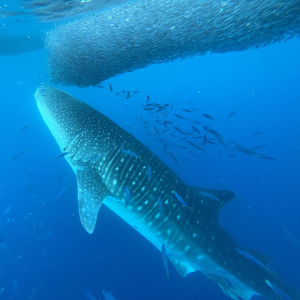University of Hawaiʻi at Mānoa researchers spotted the world’s largest fish species, a 30-foot whale shark, a mile off Kāneʻohe Bay near Kualoa Ranch on November 2.
Researchers from the Hawaiʻi Institute of Marine Biology (HIMB) Shark Research Lab were returning from conducting field work when they spotted seabirds flying over what they suspected was a bait ball, where small fish swarm in a tightly packed spherical formation near the surface while being pursued and herded by predators below.
Mark Royer, a HIMB shark researcher, went into the water to see what sealife had gathered to feed and was surprised to see the whale shark.

“It is surprising,” said Royer. “[Whale sharks] are here more often than we think, however they are probably hard to come across, because I didn’t see this animal until I hopped in the water.”
The whale shark was feeding on nehu (Hawaiian anchovy) and Royer said the video captured a large aggregation of predators both small and large including ʻopelu (mackerel scad), kawakawa (mackerel tuna), aku (skipjack tuna), sandbar sharks and seabirds, who were also feeding on the nehu.
“While all the small nehu were being drawn to the surface from all the predators, the whale shark was coming in and using its massive mouth to come up to the surface, open it, and then the suction would cause all the fish to funnel into its huge mouth,” said Royer.
Multiple sandbar sharks (approximately five feet in length) swam below the whale shark. Above the surface, birds were circling around and diving to eat the nehu. Whale sharks are known to approach boats standing idle in the water. It is important to be mindful and respectful, let them approach, and don’t aggressively approach and disturb them.
“[The whale shark] would swim and approach our boat that was nearby, put its head up to it and go back down, and repeat that over and over again,” said Royer. “That’s a behavior that whale sharks sometimes exhibit: if your boat is standing still in the water they [might] approach you. They’ve been known, both here in Hawaiʻi and other parts of the world, to do that.”
Lelewaʻa (ʻōlelo Hawaiʻi for whale shark) was likely named for their propensity to approach and lean on canoe outriggers according to the late Hawaiian historian Samuel Kamakau.
The Shark Research Lab investigates the behavior, physiology and ecology of sharks and other fish.

